Modern History of South Asia through Philatelic Eyes
by
Takashi Kurosaki
(Last Revision: June 1, 2004)
Source: Takashi Kurosaki, "Modern History of South Asia through Stamps," Gaiko Forum (a monthly forum journal on foreign affairs, published under the cooperation from the Japanese Ministry of Foreign Affairs), No. 172, November 2002, pp.52-57.
Introduction
Postage stamps are frequently called "small diplomats". Mails franked with postage stamps issued by an authorized agency are guaranteed by the Universal Postal Union (UPU) to travel all around the globe. The stamps on these mails advertise to the world about the head of the state, culture, history, politics, and economy of the origin country.
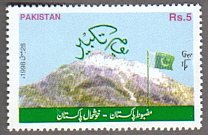 Stamps from South Asia also give us hints to understand the region. For example, the stamp on the right is a Pakistani stamp issued to celebrate one year anniversary of the country's nuclear test conducted in May 1998. While the world trembled at the sight of nuclear tests by India and Pakistan, the test indeed raised the patriotic feeling in Pakistan, which can be read from the stamp: its Urdu script says "28 May 1998 is the day of glory. Strong and flourishing Pakistan."
Stamps from South Asia also give us hints to understand the region. For example, the stamp on the right is a Pakistani stamp issued to celebrate one year anniversary of the country's nuclear test conducted in May 1998. While the world trembled at the sight of nuclear tests by India and Pakistan, the test indeed raised the patriotic feeling in Pakistan, which can be read from the stamp: its Urdu script says "28 May 1998 is the day of glory. Strong and flourishing Pakistan."
Not only stamps but also postal covers and cancellations are interesting. In South Asia, they reflect changes in political regimes and national boundaries. Collecting and studying postage stamps, cancellations, and postal history is called "philately." This article explains philatelic materials from my collection, which vividly tell us the intricacy of South Asian modern history.

Philatelic Ties between South Asia and Japan
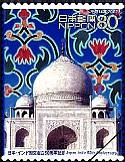
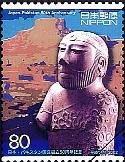
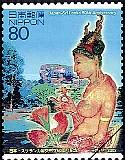
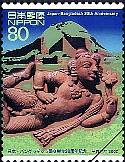 On April 2002, the Japanese Post Office issued a set of four stamps to commemorate "Japan and South Asia in the 21st Century." The one on India shows Taj Mahal and commemorates the golden jubilee of India - Japan diplomatic relations. The one on Pakistan shows Moenjo Daro excavations and commemorates the golden jubilee of Pakistan - Japan diplomatic relations. The one on Sri Lanka shows Sigiriya excavations and commemorates the golden jubilee of Sri Lanka (Ceylon) - Japan diplomatic relations. The last one on Bangladesh shows Paharpur Monastery and commemorates the 30th anniversary of Bangladesh - Japan diplomatic relations.
On April 2002, the Japanese Post Office issued a set of four stamps to commemorate "Japan and South Asia in the 21st Century." The one on India shows Taj Mahal and commemorates the golden jubilee of India - Japan diplomatic relations. The one on Pakistan shows Moenjo Daro excavations and commemorates the golden jubilee of Pakistan - Japan diplomatic relations. The one on Sri Lanka shows Sigiriya excavations and commemorates the golden jubilee of Sri Lanka (Ceylon) - Japan diplomatic relations. The last one on Bangladesh shows Paharpur Monastery and commemorates the 30th anniversary of Bangladesh - Japan diplomatic relations.
All four designs of these stamps are adopted from the world heritages in each country. However, considering the on-going communal tensions in India, it is ironical to use a Islamic building (Taj Mahal) to symbolize India. Similarly, considering the worldwide concern against Islamic fundamentalist movements in Pakistan, it is suggestive to find Moenjo Daro, which is a pre-Islam legacy of Pakistan. Regardless of the designer's intention, the commemorative stamps show the complexity of religions and cultures in South Asia.
 Before these four stamps, only two issues on South Asia have been issued from Japan. The first one was a 1956 stamp that celebrated the Japanese conquest of Mt. Manaslu of the Himalaya. The second one was a 1995 stamp that commemorated the 30the anniversary of Japan Overseas Cooperation Volunteers (JOCV). The stamp shows a JOCV lady teaching a Bangladeshi Lady how to write. From India, the India-Japan golden jubilee stamps are the first issue on Japan (see the photo left). This pair of stamps contrasts Kathakali dancers and Kabuki dancers. Both have commonalities in their make-ups. This beautiful issue was printed in a pane with special printings on margin, the first for Indian commemorative stamps (you can see the whole pane here).
Before these four stamps, only two issues on South Asia have been issued from Japan. The first one was a 1956 stamp that celebrated the Japanese conquest of Mt. Manaslu of the Himalaya. The second one was a 1995 stamp that commemorated the 30the anniversary of Japan Overseas Cooperation Volunteers (JOCV). The stamp shows a JOCV lady teaching a Bangladeshi Lady how to write. From India, the India-Japan golden jubilee stamps are the first issue on Japan (see the photo left). This pair of stamps contrasts Kathakali dancers and Kabuki dancers. Both have commonalities in their make-ups. This beautiful issue was printed in a pane with special printings on margin, the first for Indian commemorative stamps (you can see the whole pane here).
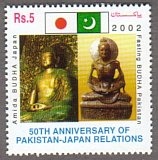 The Pakistan-Japan golden jubilee stamp also shows a contrast of cultures in the two countries (see the photo right). Now the comparisons are Buddha sculptures: Amida-Nyorai from Yakushi-Ji Temple, Japan, and the Fasting Buddha from Lahore Museum, Pakistan. Before this stamp, one set of stamps were issued by the Government of Pakistan, with Japan as its motive --- in 1969, the Pakistan International Airlines (PIA) opened a new route between Dacca and Tokyo. The two commemorative stamps are shown left below:
The Pakistan-Japan golden jubilee stamp also shows a contrast of cultures in the two countries (see the photo right). Now the comparisons are Buddha sculptures: Amida-Nyorai from Yakushi-Ji Temple, Japan, and the Fasting Buddha from Lahore Museum, Pakistan. Before this stamp, one set of stamps were issued by the Government of Pakistan, with Japan as its motive --- in 1969, the Pakistan International Airlines (PIA) opened a new route between Dacca and Tokyo. The two commemorative stamps are shown left below:
 This cut from the First Day Cover is interesting from various aspects. First, the stamps show Kimono women but their style is far from precision. They look like Geisha rather than traditional Japanese ladies in Kimono. Second, the importance of Dacca-Tokyo flight to the Pakistani economy. During this period, Japan-Pakistan trade was much important than Japan-India trade and Japan-East Pakistan connection was also strong. Third, to reduce the anti-West Pakistan feelings in East Pakistan, a number of Pakistani stamps began to adopt East Pakistan motives during the 1960s. These stamps are typical examples of this trend. It should be noted also that the country name "PAKISTAN" is given in three languages: English, Bengali, and Urdu (in this order from left to right).
This cut from the First Day Cover is interesting from various aspects. First, the stamps show Kimono women but their style is far from precision. They look like Geisha rather than traditional Japanese ladies in Kimono. Second, the importance of Dacca-Tokyo flight to the Pakistani economy. During this period, Japan-Pakistan trade was much important than Japan-India trade and Japan-East Pakistan connection was also strong. Third, to reduce the anti-West Pakistan feelings in East Pakistan, a number of Pakistani stamps began to adopt East Pakistan motives during the 1960s. These stamps are typical examples of this trend. It should be noted also that the country name "PAKISTAN" is given in three languages: English, Bengali, and Urdu (in this order from left to right).

Stamps and Territories
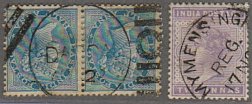 Postage stamps are usually valid only in the territory where the stamp-issuing government reigns. Therefore, changes in national boundaries can be depicted on used stamps and covers. For instance, in areas currently in Bangladesh, British Indian stamps were used before the Partition in August 1947 and Pakistani stamps were used during the 1947-1971 period. The stamps on the right show British Indian stamps used in Dacca and Mymensingh (now in Bangladesh). [More on Bangladesh Philately].
Postage stamps are usually valid only in the territory where the stamp-issuing government reigns. Therefore, changes in national boundaries can be depicted on used stamps and covers. For instance, in areas currently in Bangladesh, British Indian stamps were used before the Partition in August 1947 and Pakistani stamps were used during the 1947-1971 period. The stamps on the right show British Indian stamps used in Dacca and Mymensingh (now in Bangladesh). [More on Bangladesh Philately].
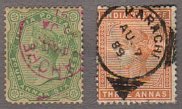 In areas currently in Pakistan, British Indian stamps were used before the 1947 Partition. The stamps on the left show British Indian stamps used in Lahore and Karachi (now in Pakistan). [More on Pakistan Philately].
In areas currently in Pakistan, British Indian stamps were used before the 1947 Partition. The stamps on the left show British Indian stamps used in Lahore and Karachi (now in Pakistan). [More on Pakistan Philately].
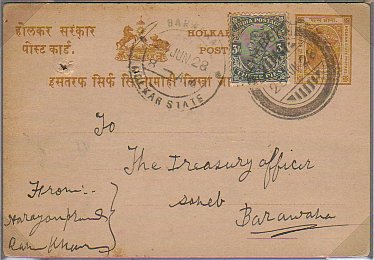 Before the Partition, not only British Indian stamps but also local stamps were used in some parts of the Empire of India. The Empire of India consisted of British Provinces and Princely States. Some of the princely states were allowed to issue their own stamps, which were valid only within the princely state. Jaipur, Travancore, and Hyderabad (Deccan) are examples of such princely states currently in India; Bahawalpur and Las Bela are the princely states in Pakistan where local stamps were issued. The post offices under the British colonial government also functioned in these states.
Before the Partition, not only British Indian stamps but also local stamps were used in some parts of the Empire of India. The Empire of India consisted of British Provinces and Princely States. Some of the princely states were allowed to issue their own stamps, which were valid only within the princely state. Jaipur, Travancore, and Hyderabad (Deccan) are examples of such princely states currently in India; Bahawalpur and Las Bela are the princely states in Pakistan where local stamps were issued. The post offices under the British colonial government also functioned in these states.
The post card on the right is an interesting example of "mixed franking". The 3 pies post card was issued by the princely state of Holkar (Indore). To meet the deficiency in postal fees, a British Indian stamp of 3 pies was added. Note that Holkar stamps and post cards were valid only in Holkar state but British Indian stamps were valid throughout India, including Holkar state. Thus this example of mixed franking was born.
 British Indian stamps were sometime used outside the Empire of India as well. For example, the British Indian stamp on the left was cancelled in Pondicherry, a French Colony at that time. Although French Indian stamps were issued and used in post offices under the French Pondicherry Government, British Indian post offices were also allowed to function in French colonies in India. About 250 stamps were issued from the French Indian Government. A similar situation is found in Portuguese colonies in India, such as Goa. About 700 stamps were issued from the Portuguese Indian Government but British Indian post offices also functioned there. Some customers in these colonies were well aware of the timing of postal ships and flights. They deliberately chose which post offices to use.
British Indian stamps were sometime used outside the Empire of India as well. For example, the British Indian stamp on the left was cancelled in Pondicherry, a French Colony at that time. Although French Indian stamps were issued and used in post offices under the French Pondicherry Government, British Indian post offices were also allowed to function in French colonies in India. About 250 stamps were issued from the French Indian Government. A similar situation is found in Portuguese colonies in India, such as Goa. About 700 stamps were issued from the Portuguese Indian Government but British Indian post offices also functioned there. Some customers in these colonies were well aware of the timing of postal ships and flights. They deliberately chose which post offices to use.
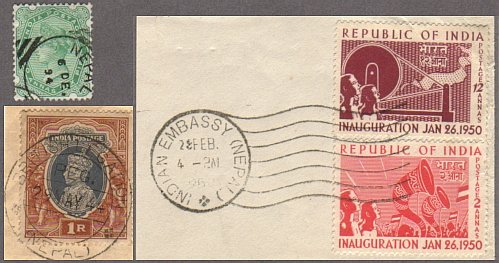 There is no such complexities in Ceylon (currently Sri Lanka). When the modern postal system was introduced to Ceylon Island in the mid 19th century, the island was already a British colony and no other post offices functioned. Another interesting case is Nepal. The first stamp of Nepal was issued in 1881 and there was no change in national boundaries. Nevertheless, due to Nepal's isolation policies in foreign affairs until the 1950s, the country joined the UPU only as late as in 1959. Before this, Nepalese stamps were not valid outside the country. To send mails from Nepal to foreign countries, British Indian post offices (until August 1947) and Indian posit offices (1947-59) in Nepal were used. Indian stamps were used there. The photo on the right shows such examples: the green 2.5 annas British Indian stamp was cancelled "NEPAL" (used in 1894); the 1 Re British Indian stamp was cancelled "BRITISH LEGATION, NEPAL" (used in 1944); the two Indian stamps were cancelled "INDIAN EMBASSY, NEPAL" (used in 1950).
There is no such complexities in Ceylon (currently Sri Lanka). When the modern postal system was introduced to Ceylon Island in the mid 19th century, the island was already a British colony and no other post offices functioned. Another interesting case is Nepal. The first stamp of Nepal was issued in 1881 and there was no change in national boundaries. Nevertheless, due to Nepal's isolation policies in foreign affairs until the 1950s, the country joined the UPU only as late as in 1959. Before this, Nepalese stamps were not valid outside the country. To send mails from Nepal to foreign countries, British Indian post offices (until August 1947) and Indian posit offices (1947-59) in Nepal were used. Indian stamps were used there. The photo on the right shows such examples: the green 2.5 annas British Indian stamp was cancelled "NEPAL" (used in 1894); the 1 Re British Indian stamp was cancelled "BRITISH LEGATION, NEPAL" (used in 1944); the two Indian stamps were cancelled "INDIAN EMBASSY, NEPAL" (used in 1950).

India and Pakistan Used Abroad
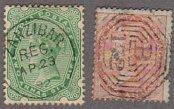 Especially interesting materials are British Indian and Pakistani stamps used abroad. In the 19th century, the British Government utilized British Indian post offices to start up modern postal systems in British colonies or to compete with other post offices. Such areas include the Middle East, East Africa, and South-East Asia. British Indian stamps were used in these post offices and keenly collected by philatelists as "India Used Abroad".
Especially interesting materials are British Indian and Pakistani stamps used abroad. In the 19th century, the British Government utilized British Indian post offices to start up modern postal systems in British colonies or to compete with other post offices. Such areas include the Middle East, East Africa, and South-East Asia. British Indian stamps were used in these post offices and keenly collected by philatelists as "India Used Abroad".
The photo on the left shows two such examples. The green 2.5 annas British Indian stamp was cancelled "ZANZIBAR" in Africa in 1892. The brown 2 annas stamp was cancelled "B 172", which indicates that the stamp was used in Singapore around 1860.
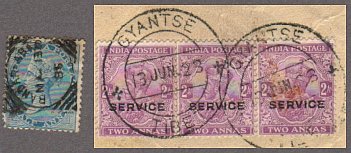 The photo on the right shows examples of Indian post offices that competed with local post offices. The blue 0.5 anna British Indian stamp was cancelled "BANDAR ABBAS" in Persia in 1885. A strip of three of 2 annas lilac British Indian stamps was used in Gyantse, Tibet in 1923.
The photo on the right shows examples of Indian post offices that competed with local post offices. The blue 0.5 anna British Indian stamp was cancelled "BANDAR ABBAS" in Persia in 1885. A strip of three of 2 annas lilac British Indian stamps was used in Gyantse, Tibet in 1923.
Since British Burma was a part of the British Empire of India from 1886 to 1937, British Indian stamps were used in post offices in British Burma during this period are not strictly "used abroad." But collectors usually call them "India Used in Burma" and classify them as a part of "India Used Abroad" collection.
 Most of British Indian post offices abroad were closed before the Partition in 1947. There were a few exceptions. The first was the case of Nepal mentioned above. The second was the post offices in Dubai and Muscat in the Gulf Region. When the British India was partitioned into India and Pakistan, British Indian post offices in Dubai and Muscat were inherited by Pakistan and managed by Karachi GPO. These post offices initially used British Indian stamps and then those stamps overprinted "PAKISTAN." The post offices were closed on 1 April 1948. This chronology implies that "PAKISTAN" overprinted stamps were used in Dubai and Muscat only for 6 months from 1 Oct 1947 to 31 March 1948. The photo on the left shows an example of this usage. The PAKISTAN overprinted stamps were cancelled in Dubai on 27 Jan. 1948 and sent to Bombay.
Most of British Indian post offices abroad were closed before the Partition in 1947. There were a few exceptions. The first was the case of Nepal mentioned above. The second was the post offices in Dubai and Muscat in the Gulf Region. When the British India was partitioned into India and Pakistan, British Indian post offices in Dubai and Muscat were inherited by Pakistan and managed by Karachi GPO. These post offices initially used British Indian stamps and then those stamps overprinted "PAKISTAN." The post offices were closed on 1 April 1948. This chronology implies that "PAKISTAN" overprinted stamps were used in Dubai and Muscat only for 6 months from 1 Oct 1947 to 31 March 1948. The photo on the left shows an example of this usage. The PAKISTAN overprinted stamps were cancelled in Dubai on 27 Jan. 1948 and sent to Bombay.
The Gulf region is currently known with numerous Pakistani workers. One aspect of the historical connection between Pakistan and the Gulf is shown vividly in this cover.
Back to Tak's Philately, Main Page

 Stamps from South Asia also give us hints to understand the region. For example, the stamp on the right is a Pakistani stamp issued to celebrate one year anniversary of the country's nuclear test conducted in May 1998. While the world trembled at the sight of nuclear tests by India and Pakistan, the test indeed raised the patriotic feeling in Pakistan, which can be read from the stamp: its Urdu script says "28 May 1998 is the day of glory. Strong and flourishing Pakistan."
Stamps from South Asia also give us hints to understand the region. For example, the stamp on the right is a Pakistani stamp issued to celebrate one year anniversary of the country's nuclear test conducted in May 1998. While the world trembled at the sight of nuclear tests by India and Pakistan, the test indeed raised the patriotic feeling in Pakistan, which can be read from the stamp: its Urdu script says "28 May 1998 is the day of glory. Strong and flourishing Pakistan."



 On April 2002, the Japanese Post Office issued a set of four stamps to commemorate "Japan and South Asia in the 21st Century." The one on India shows Taj Mahal and commemorates the golden jubilee of India - Japan diplomatic relations. The one on Pakistan shows Moenjo Daro excavations and commemorates the golden jubilee of Pakistan - Japan diplomatic relations. The one on Sri Lanka shows Sigiriya excavations and commemorates the golden jubilee of Sri Lanka (Ceylon) - Japan diplomatic relations. The last one on Bangladesh shows Paharpur Monastery and commemorates the 30th anniversary of Bangladesh - Japan diplomatic relations.
On April 2002, the Japanese Post Office issued a set of four stamps to commemorate "Japan and South Asia in the 21st Century." The one on India shows Taj Mahal and commemorates the golden jubilee of India - Japan diplomatic relations. The one on Pakistan shows Moenjo Daro excavations and commemorates the golden jubilee of Pakistan - Japan diplomatic relations. The one on Sri Lanka shows Sigiriya excavations and commemorates the golden jubilee of Sri Lanka (Ceylon) - Japan diplomatic relations. The last one on Bangladesh shows Paharpur Monastery and commemorates the 30th anniversary of Bangladesh - Japan diplomatic relations. Before these four stamps, only two issues on South Asia have been issued from Japan. The first one was a 1956 stamp that celebrated the Japanese conquest of Mt. Manaslu of the Himalaya. The second one was a 1995 stamp that commemorated the 30the anniversary of Japan Overseas Cooperation Volunteers (JOCV). The stamp shows a JOCV lady teaching a Bangladeshi Lady how to write. From India, the India-Japan golden jubilee stamps are the first issue on Japan (see the photo left). This pair of stamps contrasts Kathakali dancers and Kabuki dancers. Both have commonalities in their make-ups. This beautiful issue was printed in a pane with special printings on margin, the first for Indian commemorative stamps (you can see the whole pane here).
Before these four stamps, only two issues on South Asia have been issued from Japan. The first one was a 1956 stamp that celebrated the Japanese conquest of Mt. Manaslu of the Himalaya. The second one was a 1995 stamp that commemorated the 30the anniversary of Japan Overseas Cooperation Volunteers (JOCV). The stamp shows a JOCV lady teaching a Bangladeshi Lady how to write. From India, the India-Japan golden jubilee stamps are the first issue on Japan (see the photo left). This pair of stamps contrasts Kathakali dancers and Kabuki dancers. Both have commonalities in their make-ups. This beautiful issue was printed in a pane with special printings on margin, the first for Indian commemorative stamps (you can see the whole pane here). The Pakistan-Japan golden jubilee stamp also shows a contrast of cultures in the two countries (see the photo right). Now the comparisons are Buddha sculptures: Amida-Nyorai from Yakushi-Ji Temple, Japan, and the Fasting Buddha from Lahore Museum, Pakistan. Before this stamp, one set of stamps were issued by the Government of Pakistan, with Japan as its motive --- in 1969, the Pakistan International Airlines (PIA) opened a new route between Dacca and Tokyo. The two commemorative stamps are shown left below:
The Pakistan-Japan golden jubilee stamp also shows a contrast of cultures in the two countries (see the photo right). Now the comparisons are Buddha sculptures: Amida-Nyorai from Yakushi-Ji Temple, Japan, and the Fasting Buddha from Lahore Museum, Pakistan. Before this stamp, one set of stamps were issued by the Government of Pakistan, with Japan as its motive --- in 1969, the Pakistan International Airlines (PIA) opened a new route between Dacca and Tokyo. The two commemorative stamps are shown left below:
 This cut from the First Day Cover is interesting from various aspects. First, the stamps show Kimono women but their style is far from precision. They look like Geisha rather than traditional Japanese ladies in Kimono. Second, the importance of Dacca-Tokyo flight to the Pakistani economy. During this period, Japan-Pakistan trade was much important than Japan-India trade and Japan-East Pakistan connection was also strong. Third, to reduce the anti-West Pakistan feelings in East Pakistan, a number of Pakistani stamps began to adopt East Pakistan motives during the 1960s. These stamps are typical examples of this trend. It should be noted also that the country name "PAKISTAN" is given in three languages: English, Bengali, and Urdu (in this order from left to right).
This cut from the First Day Cover is interesting from various aspects. First, the stamps show Kimono women but their style is far from precision. They look like Geisha rather than traditional Japanese ladies in Kimono. Second, the importance of Dacca-Tokyo flight to the Pakistani economy. During this period, Japan-Pakistan trade was much important than Japan-India trade and Japan-East Pakistan connection was also strong. Third, to reduce the anti-West Pakistan feelings in East Pakistan, a number of Pakistani stamps began to adopt East Pakistan motives during the 1960s. These stamps are typical examples of this trend. It should be noted also that the country name "PAKISTAN" is given in three languages: English, Bengali, and Urdu (in this order from left to right).
 Postage stamps are usually valid only in the territory where the stamp-issuing government reigns. Therefore, changes in national boundaries can be depicted on used stamps and covers. For instance, in areas currently in Bangladesh, British Indian stamps were used before the Partition in August 1947 and Pakistani stamps were used during the 1947-1971 period. The stamps on the right show British Indian stamps used in Dacca and Mymensingh (now in Bangladesh). [More on Bangladesh Philately].
Postage stamps are usually valid only in the territory where the stamp-issuing government reigns. Therefore, changes in national boundaries can be depicted on used stamps and covers. For instance, in areas currently in Bangladesh, British Indian stamps were used before the Partition in August 1947 and Pakistani stamps were used during the 1947-1971 period. The stamps on the right show British Indian stamps used in Dacca and Mymensingh (now in Bangladesh). [More on Bangladesh Philately]. In areas currently in Pakistan, British Indian stamps were used before the 1947 Partition. The stamps on the left show British Indian stamps used in Lahore and Karachi (now in Pakistan). [More on Pakistan Philately].
In areas currently in Pakistan, British Indian stamps were used before the 1947 Partition. The stamps on the left show British Indian stamps used in Lahore and Karachi (now in Pakistan). [More on Pakistan Philately]. Before the Partition, not only British Indian stamps but also local stamps were used in some parts of the Empire of India. The Empire of India consisted of British Provinces and Princely States. Some of the princely states were allowed to issue their own stamps, which were valid only within the princely state. Jaipur, Travancore, and Hyderabad (Deccan) are examples of such princely states currently in India; Bahawalpur and Las Bela are the princely states in Pakistan where local stamps were issued. The post offices under the British colonial government also functioned in these states.
Before the Partition, not only British Indian stamps but also local stamps were used in some parts of the Empire of India. The Empire of India consisted of British Provinces and Princely States. Some of the princely states were allowed to issue their own stamps, which were valid only within the princely state. Jaipur, Travancore, and Hyderabad (Deccan) are examples of such princely states currently in India; Bahawalpur and Las Bela are the princely states in Pakistan where local stamps were issued. The post offices under the British colonial government also functioned in these states. British Indian stamps were sometime used outside the Empire of India as well. For example, the British Indian stamp on the left was cancelled in Pondicherry, a French Colony at that time. Although French Indian stamps were issued and used in post offices under the French Pondicherry Government, British Indian post offices were also allowed to function in French colonies in India. About 250 stamps were issued from the French Indian Government. A similar situation is found in Portuguese colonies in India, such as Goa. About 700 stamps were issued from the Portuguese Indian Government but British Indian post offices also functioned there. Some customers in these colonies were well aware of the timing of postal ships and flights. They deliberately chose which post offices to use.
British Indian stamps were sometime used outside the Empire of India as well. For example, the British Indian stamp on the left was cancelled in Pondicherry, a French Colony at that time. Although French Indian stamps were issued and used in post offices under the French Pondicherry Government, British Indian post offices were also allowed to function in French colonies in India. About 250 stamps were issued from the French Indian Government. A similar situation is found in Portuguese colonies in India, such as Goa. About 700 stamps were issued from the Portuguese Indian Government but British Indian post offices also functioned there. Some customers in these colonies were well aware of the timing of postal ships and flights. They deliberately chose which post offices to use. There is no such complexities in Ceylon (currently Sri Lanka). When the modern postal system was introduced to Ceylon Island in the mid 19th century, the island was already a British colony and no other post offices functioned. Another interesting case is Nepal. The first stamp of Nepal was issued in 1881 and there was no change in national boundaries. Nevertheless, due to Nepal's isolation policies in foreign affairs until the 1950s, the country joined the UPU only as late as in 1959. Before this, Nepalese stamps were not valid outside the country. To send mails from Nepal to foreign countries, British Indian post offices (until August 1947) and Indian posit offices (1947-59) in Nepal were used. Indian stamps were used there. The photo on the right shows such examples: the green 2.5 annas British Indian stamp was cancelled "NEPAL" (used in 1894); the 1 Re British Indian stamp was cancelled "BRITISH LEGATION, NEPAL" (used in 1944); the two Indian stamps were cancelled "INDIAN EMBASSY, NEPAL" (used in 1950).
There is no such complexities in Ceylon (currently Sri Lanka). When the modern postal system was introduced to Ceylon Island in the mid 19th century, the island was already a British colony and no other post offices functioned. Another interesting case is Nepal. The first stamp of Nepal was issued in 1881 and there was no change in national boundaries. Nevertheless, due to Nepal's isolation policies in foreign affairs until the 1950s, the country joined the UPU only as late as in 1959. Before this, Nepalese stamps were not valid outside the country. To send mails from Nepal to foreign countries, British Indian post offices (until August 1947) and Indian posit offices (1947-59) in Nepal were used. Indian stamps were used there. The photo on the right shows such examples: the green 2.5 annas British Indian stamp was cancelled "NEPAL" (used in 1894); the 1 Re British Indian stamp was cancelled "BRITISH LEGATION, NEPAL" (used in 1944); the two Indian stamps were cancelled "INDIAN EMBASSY, NEPAL" (used in 1950).
 Especially interesting materials are British Indian and Pakistani stamps used abroad. In the 19th century, the British Government utilized British Indian post offices to start up modern postal systems in British colonies or to compete with other post offices. Such areas include the Middle East, East Africa, and South-East Asia. British Indian stamps were used in these post offices and keenly collected by philatelists as "India Used Abroad".
Especially interesting materials are British Indian and Pakistani stamps used abroad. In the 19th century, the British Government utilized British Indian post offices to start up modern postal systems in British colonies or to compete with other post offices. Such areas include the Middle East, East Africa, and South-East Asia. British Indian stamps were used in these post offices and keenly collected by philatelists as "India Used Abroad". The photo on the right shows examples of Indian post offices that competed with local post offices. The blue 0.5 anna British Indian stamp was cancelled "BANDAR ABBAS" in Persia in 1885. A strip of three of 2 annas lilac British Indian stamps was used in Gyantse, Tibet in 1923.
The photo on the right shows examples of Indian post offices that competed with local post offices. The blue 0.5 anna British Indian stamp was cancelled "BANDAR ABBAS" in Persia in 1885. A strip of three of 2 annas lilac British Indian stamps was used in Gyantse, Tibet in 1923. Most of British Indian post offices abroad were closed before the Partition in 1947. There were a few exceptions. The first was the case of Nepal mentioned above. The second was the post offices in Dubai and Muscat in the Gulf Region. When the British India was partitioned into India and Pakistan, British Indian post offices in Dubai and Muscat were inherited by Pakistan and managed by Karachi GPO. These post offices initially used British Indian stamps and then those stamps overprinted "PAKISTAN." The post offices were closed on 1 April 1948. This chronology implies that "PAKISTAN" overprinted stamps were used in Dubai and Muscat only for 6 months from 1 Oct 1947 to 31 March 1948. The photo on the left shows an example of this usage. The PAKISTAN overprinted stamps were cancelled in Dubai on 27 Jan. 1948 and sent to Bombay.
Most of British Indian post offices abroad were closed before the Partition in 1947. There were a few exceptions. The first was the case of Nepal mentioned above. The second was the post offices in Dubai and Muscat in the Gulf Region. When the British India was partitioned into India and Pakistan, British Indian post offices in Dubai and Muscat were inherited by Pakistan and managed by Karachi GPO. These post offices initially used British Indian stamps and then those stamps overprinted "PAKISTAN." The post offices were closed on 1 April 1948. This chronology implies that "PAKISTAN" overprinted stamps were used in Dubai and Muscat only for 6 months from 1 Oct 1947 to 31 March 1948. The photo on the left shows an example of this usage. The PAKISTAN overprinted stamps were cancelled in Dubai on 27 Jan. 1948 and sent to Bombay.